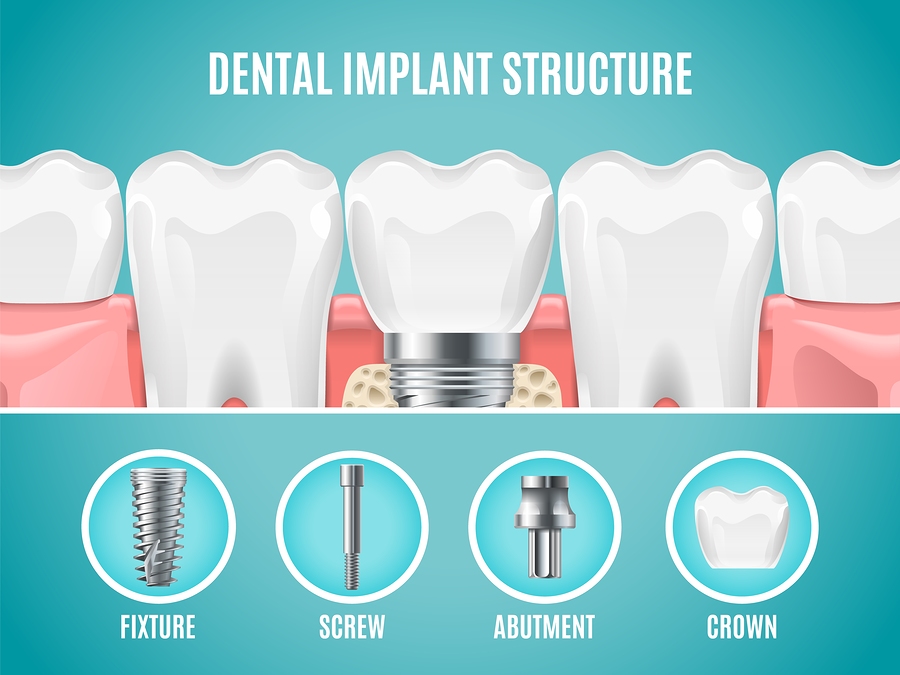How Dental Sense can Save You Time, Stress, and Money.
How Dental Sense can Save You Time, Stress, and Money.
Blog Article
The Best Guide To Dental Sense
Table of ContentsTop Guidelines Of Dental SenseMore About Dental SenseDental Sense Can Be Fun For AnyoneOur Dental Sense PDFs
are medical tools operatively implanted into the jaw to bring back an individual's capacity to eat or their look. They provide support for synthetic (fake) teeth, such as crowns, bridges, or dentures. When a tooth is lost as a result of injury or illness, an individual can experience complications such as quick bone loss, malfunctioning speech, or changes to chewing patterns that cause discomfort.Dental implant systems contain a dental implant body and oral implant joint and may likewise include an abutment fixation screw. Kids dental. The dental implant body is surgically put in the jawbone instead of the tooth's origin. The dental implant abutment is typically connected to the implant body by the joint fixation screw and expands through periodontals right into the mouth to sustain the attached synthetic teeth
(https://medium.com/@matthewmusic33101/about)Framework of The Dental Implant System choosing oral implants, talk to your oral company about the prospective advantages and threats, and whether you are a prospect for the procedure. Points to think about: Your overall wellness is an essential consider determining whether you are a great prospect for dental implants, the length of time it will certainly take to recover, and how long the implant may stay in place.
Smoking might influence the recovery process and reduce the lasting success of the dental implant. The recovery process for the implant body might take numerous months or longer, throughout which time you usually have a short-lived joint in area of the tooth. the oral implant treatment: Very carefully adhere to the dental health directions offered to you by your oral supplier.
Dental Sense for Dummies
Implant failure can result in the need for one more surgery to fix or change the implant system. Recovers the capability to eat Recovers aesthetic appearance Aids keep the jawbone from reducing due to bone loss Preserves the wellness of the surrounding bone and gums Aids keep adjacent (nearby) teeth stable Boosts top quality of life Damage to surrounding natural teeth throughout dental implant placement Injury to the surrounding tissues during surgery, such as sinus opening Injury throughout surgical treatment (as an example, fracture of surrounding jawbone) Poor feature, such as seeming like the teeth do not bite together generally An experience that the tooth is loose or twisting in position resulting from an abutment screw loosening up Implant body failure (looseness of the implant body) due to systemic infection, which might be more probable in patients with unrestrained diabetes as a result of regional infection in bone and gums supporting the implant body as a result of postponed healing, which may be most likely in people that smoke Difficulty cleansing the gum tissues around the implant, resulting in inadequate oral health Neglected gum condition Post-surgical tingling as a result of nerve impingement or damage Constantly alert healthcare service providers and imaging specialists that you have oral implants prior to any kind of magnetic resonance imaging (MRI) or x-ray treatments.
FDA is not conscious of any type of negative occasions reported for MRI or x-ray procedures with dental implants. Dental implants systems are typically constructed from products that comply with worldwide consensus requirements of the International Organization for Standardization (ISO) or ASTM International. These requirements have information of what makes a safe product.

A dental implant is a structure that changes a missing out on tooth. With screw-like gadgets, the specialist inserts a dental implant into the jawbone, and it acts as an anchor for a man-made tooth, called a crown. A tool called a joint attaches the man-made tooth to the oral implant. The crown is personalized to fit the person's mouth and match the color of their teeth.
Not known Details About Dental Sense
Some people are not qualified for oral implant surgical treatment. It is for dental specialists to operate on people with: acute illnessuncontrollable metabolic diseasebone or soft cells condition or infectionIf these concerns are solved, a person can have the surgery. In, oral surgeons avoid operating people with: If individuals with any of the above undergo dental implant surgical procedure, there is a higher threat of the implant failing.

Oral implant surgical treatment is an individualized procedure. Give you time to heal. Attach the article and last crown, bridge or denture.
Next, your doctor will meticulously put the dental implant right into your jaw. Your cosmetic surgeon will rearrange your periodontals and close the cut with stitches. If your implant is near the front of your mouth, your dental practitioner will make a momentary tooth for you to wear till you recover. That way, you won't have a void in your smile while you recover.
The Facts About Dental Sense Revealed
Throughout the recovery stage, your jawbone needs to fuse to the oral implant. This process can take anywhere from 3 to nine months.
As soon as your implant heals, your dental professional can affix the joint (small connector post) and your last restoration (crown, bridge or denture). This typically takes regarding one hour to complete and YOURURL.com might call for a second minor surgery. You should not really feel any pain during your dental implant treatment because your provider will make use of medicine to numb your gum tissues.
Report this page